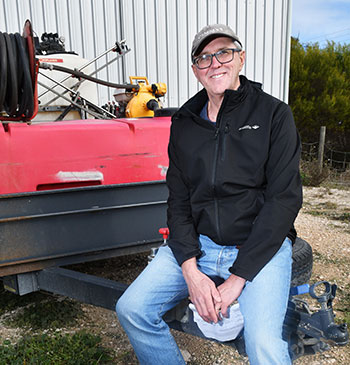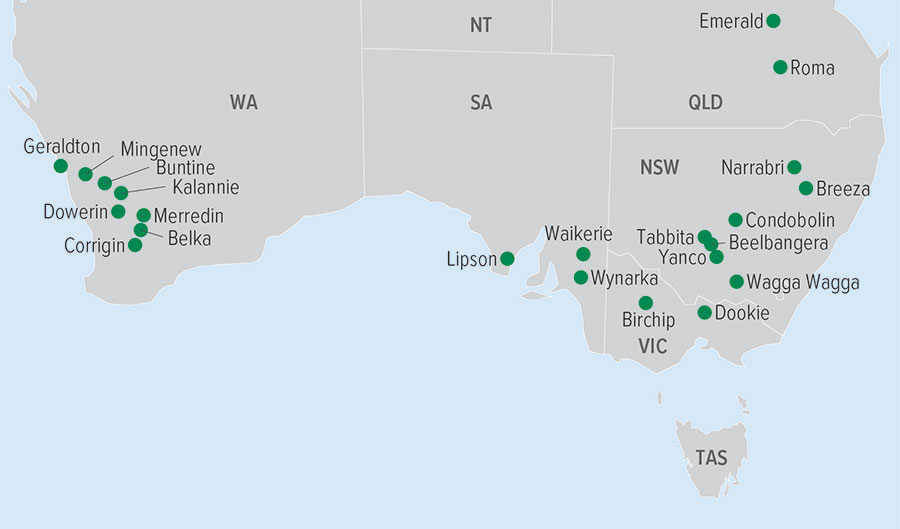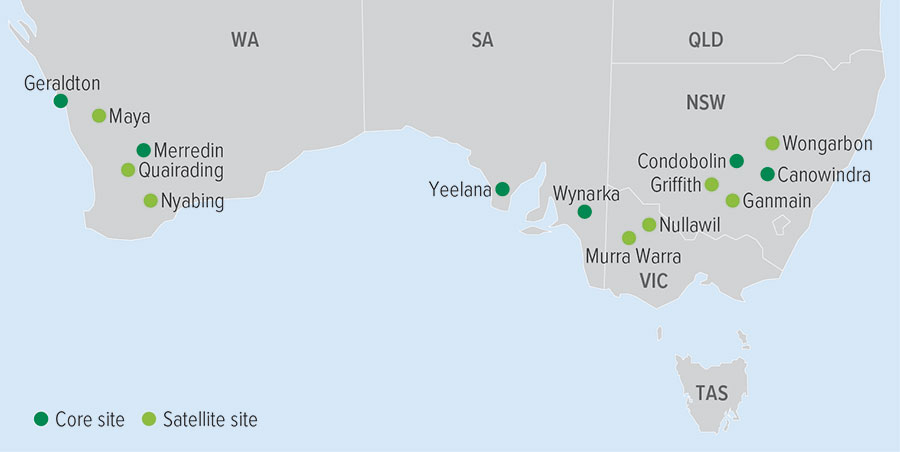Two GRDC-supported CSIRO projects with trials at the same property in South Australia are rewriting the rules and expectations around establishing canola and long coleoptile wheat under dry, hot and marginal moisture conditions
CSIRO farming systems research agronomist Dr Kenton Porker dreams of a day when he will see crops successfully established without any autumn rainfall. And this year, on the sandy soils of the Mallee, he came close.
In 2024, grain growers across SA had to wait until the final day of May for an autumn break. It has provided invaluable insights for a range of trials specifically focused on crop establishment in hot, dry and marginal conditions.
Dr Porker oversees canola trials at Wynarka and several other sites through SA as part of GRDC’s national canola crop establishment initiative led by CSIRO’s Dr Andrew Fletcher. The Wynarka plots using a vigorous hybrid variety are showing that canola can be sown more deeply and emerge more consistently on less water than previously thought.
Meanwhile, a few hundred metres away, similar findings are being revealed in relation to wheat.
Led by CSIRO senior research scientist Dr Greg Rebetzke, the second GRDC project is looking at how to best establish new wheat varieties bred with long coleoptiles – a sheath that protects first shoots – enabling deeper sowing to take advantage of stored soil moisture.
 Dr Greg Rebetzke. Photo: Melissa Marino
Dr Greg Rebetzke. Photo: Melissa Marino
Dr Rebetzke says there are many advantages of having two national GRDC projects focused on crop establishment and deep sowing at the same site, under the same conditions – not the least being a recent crop establishment showcase that brought more than 100 researchers, agronomists and growers together to learn about the developments.
Dr Porker says there are several synergies between the two projects that are both looking at optimising establishment in crops sown dry and deeper than conventional practice. “These projects bring together genetics, crop physiology, agronomy and engineering with multidisciplinary teams working together to solve one of the nation’s biggest challenges.”
GRDC grower relations manager – south – Rebekah Starick says the two projects were intentionally located in the same geographic region to allow for critical research comparisons and deliver learnings that could guide grower decision-making in marginal cropping areas.
“GRDC has invested significantly in these two important projects that are designed to help growers understand the tactics they might be able to use on-farm to improve wheat and canola establishment in dry seasons in marginal areas,” she says.
“They also have a key role in terms of building growers’ confidence, because we know that crop establishment is a major concern across the Mallee.”
Establishing canola thresholds
Canola is not as widely grown in the Mallee, potentially because of concerns regarding establishment in marginal soils. These trials are building data to provide more confidence around investing in seed and making the most of establishment opportunities, Dr Porker says.
In Wynarka’s sandy soils, the research is looking to establish thresholds for temperature and water for canola establishment to inform practical interventions. Dr Porker says the temperature of soil rather than the atmosphere is a key factor.
“The shallow seedbed can be up to 10˚C hotter than the air temperature, so we have to think about this little canola seed trying to establish in that environment,” he says. Laboratory tests led by Dr Fletcher, backed up by the field trials, are showing germination rates rapidly decline once the soil reaches 38˚C.
Soil moisture is also a consideration. Dr Porker says the Wynarka plots, sown from 28 March, have shown canola can be established on lower soil water levels than previously thought.
For canola establishment, Dr Porker says the soil moisture content of sand and most soils needs to be above plant wilting point for at least four days. In sandy soils, the trials have shown this can be achieved on as little as five to six millimetres of rain in mid-April. Earlier in autumn, when the days are hotter and longer, eight to 10mm of rain is required for the soil to sustain conditions above a plant’s wilting point.
These thresholds should provide some optimism for growers considering canola in a rotation, he says. “We can probably establish canola in the Mallee around Wynarka in two out of three seasons, as opposed to our old thinking, putting it at one in three,” he says.
In heavier clay soils, due to a higher water-holding capacity at plant wilting point, more than 15mm of rainfall is required for successful canola establishment. This is important to keep in mind given the varying nature of soil types across paddocks, he says.
A rapidly drying seedbed is also one of the biggest challenges for establishing crops in warmer conditions. But Dr Porker says at deeper levels (below three centimetres), soils dry out more slowly, retain moisture more readily and are also cooler. “So, the next phase of the research is understanding the risks and solutions around deeper sowing.”
Figure 1: Location of long coleoptile wheat 2023 experimental sites.
Excludes replicate seed-increase sites for growing and harvesting of pure seed for sowing in 2024.

Source: CSIRO
Emerging from depth
In previous research, Dr Porker has shown that canola can emerge more successfully from depth in sandier soils than on heavier types. This is because sandy soils do not compact as tightly around the seedbed, providing less resistance for a seedling to push through.
Seeder set-up will also influence the ability of a plant to emerge from depth, and the Wynarka trials are investigating how press wheel pressure and width contribute to soil compaction and crop establishment.
Seed quality and genetics are also key factors in establishment from depth. Canola bred with a longer hypocotyl (the plant’s first stem) will be trialled in 2025, but the strength and energy of an individual seed, regardless of hypocotyl length, is also important, Dr Porker says.
On the neighbouring long coleoptile wheat project led by Dr Rebetzke, good quality and larger seed size is also emerging as a critical factor for successful establishment.
New wheat varieties bred with long coleoptiles can be sown to greater depths than conventional wheat to seek stored moisture, but Dr Rebetzke says it is no easy task to emerge from more than 10cm underground.
“From deep seeding you don’t have the benefit of sunlight and other synthesis to feed you – you’re totally reliant on the energy and the quality of the seed,” he says.
So seed size should be a consideration for making a final decision around sowing depth.
Dr Rebetzke says the research will help to establish best practice agronomy in relation to new long coleoptile varieties and build confidence in the “transformational” technology to aid adoption.
The Wynarka site is one of 22 field plots across the Australian wheatbelt, along with 30 laboratory and glasshouse trials that make up the national program looking at long coleoptile wheat performance and deep sowing.
Seed size, dressings, temperature, soil types, pre-emergent herbicide and fertiliser placement are some of the many factors being studied.
Figure 2: Map of core and satellite canola establishment trial sites across Australia for the project.

Source: CSIRO
Engineering matters
In both the canola and wheat trials, optimising seeder set-up is central to the research.
Dr Jack Desbiolles from the University of South Australia provides technical support to the long coleoptile wheat project. He is helping to adapt and modify plot seeders for a range of deep sowing trials in contrasting soil types, including seeding system solutions to reduce soil throw, provide alternative fertiliser placement and optimise furrow packing. This knowledge is also shared with the canola project.
Using one such solution, CSIRO’s Dr Therese McBeath is looking at the impact of separately placing fertiliser along the same lateral plane as the seed – rather than below it.
She is comparing integrated seeding openers that can band seed and fertiliser side by side at the furrow base, versus single shoot seeding and vertical separation (where seeds are placed at the furrow base and fertiliser above the seeds, and which is often a first option adopted by growers when deep sowing.) These evaluations are to assess how to best aid crop establishment, avoid toxicity and improve fertiliser use efficiency.
A range of press wheel weights and widths are also being trialled with wheat to demonstrate ways to mitigate the risks of crop emergence loss when crops are sown deep.
Dr Desbiolles says the common press wheel packing action is not often an issue in shallow sowing, but can become a restriction when combined with the extra depth of soil cover in deep sowing. Furrow closing solutions and thresholds of furrow packing pressure across different soil contexts need to be reconsidered, he says.
Dr Desbiolles is hopeful a range of engineering solutions can be adapted to many types of seeders to facilitate deep sowing. “We need to validate practical modifications that can be adopted on-farm to enable ‘safe deep sowing’ and assist the adoption of long coleoptile wheat technology,” he says.

Dr Jack Desbiolles. Photo: Melissa Marino
Canola establishment at a glance
The GRDC and CSIRO national canola establishment project is a four-year, $8.2 million investment aimed at “reducing risks to canola establishment through an integrated understanding of genetics, management and environment”. Running until mid-2026, it will deliver new management packages to Australian grain growers to increase the reliability of canola establishment.
Trials in WA, SA, Victoria and NSW are combining sowing date, depth and irrigation to identify critical thresholds of soil moisture and temperature to maximise establishment.
Canola is Australia’s third largest and second most valuable winter crop. More than 8.9 million tonnes were sold in 2022-23, with a value of almost $6.6 billion.
But feedback from GRDC’s National Grower Network has found establishment is an ongoing constraint and concern for growers.
The project builds on a $13.2 million GRDC investment with CSIRO from 2019, which focused on genetics to help canola breeders develop varieties that better establish in growers’ paddocks.
Led by Dr Andrew Fletcher from CSIRO, the project includes EPAG Research, the WA Department of Primary Industries and Regional Development, NSW Department of Primary Industries and Regional Development, Living Farm, Birchip Cropping Group, Brill Ag, Ag Grow, Grain Orana Alliance and AgInnovate.
There are six core research sites at Geraldton and Merredin in WA, Wynarka and Ungarra in SA, and Condobolin and Canowindra in NSW. Three satellite sites in each state are focused on on-farm practices to improve establishment.
Long coleoptile wheat at a glance
The GRDC and CSIRO national long coleoptile wheat project is a $12.7 million, four-year investment aimed at supporting the integration of these varieties into cropping systems.
The coleoptile is a sheath that protects a wheat plant’s first shoots, so a greater length allows crops to be sown deeper to access stored soil moisture. Modelling suggests yields could increase by 20 per cent with long coleoptile or ‘moisture-seeking’ varieties.
To successfully integrate long coleoptile wheat into Australian farming systems, grain growers and seed companies require an understanding of complex environmental and management interactions.
The project will run until mid-2026, with national trials exploring a range of genetic, environmental and management factors relating to long coleoptile wheat implementation. It will also involve the development of a common industry standard for measuring and defining categories for wheat coleoptile length.
The project builds on decades of research by CSIRO and previous GRDC investments worth about $11.5 million introducing new climate-adaptive traits into commercial wheat varieties.
Wheat is Australia’s largest and most valuable crop with 41.2 million tonnes of wheat sold with a local value of $13.5 billion in 2022-23.
Led by Dr Greg Rebetzke from CSIRO, the project partners include the University of Melbourne, NSW Department of Primary Industries and Regional Development, Queensland Department of Agriculture and Forestry, SLR Agriculture, WA Department of Primary Industries and Regional Development, the University of South Australia and EPAG Research.

























































